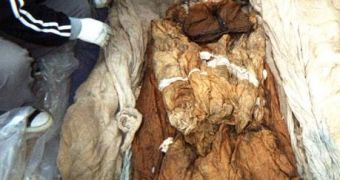We have become more familiar with the Egyptian mummies. Or the Peruvian or Siberian ones. Now, scientists have been surprised to find a drove of mummies in South Korea.
Accidentally mummified, the 700-year-old bodies could come with clues to prevent a deadly modern-day infection but they also reveal an Asian variant of Romeo and Juliet, strikingly similar with the original.
One of the mummies still contains traces of the hepatitis B virus and could help in the study of modern version of the deadly liver infection. The mummies were found while a cemetery was being relocated to make space for the construction of new buildings.
Apparently, it was strange as Korea has had a long tradition of ancestor worship and bodies were let to decay without external interference. They can be explained only by a new burial process developed in the late 1300s.
"The people believed the body should dissolve in anatural manner, without external factors such as worms. This is why they developed a special burial custom." said Mark Spigelman of the Hebrew University of Jerusalem, specialized on ancient diseases found on mummified bodies around the world.
The body was laid on ice for 3 to 30 days during mourning. The corpse was placed inside an inner and an outer pine coffin surrounded by the clothes of the deceased and the coffin was located in a lime soil mixture.
"In some cases, this inadvertently resulted in extremely good natural mummification. They didn't expect mummification and, in fact, that's the one thing they wouldn't want. The unusual Korean burial practice actually led to much better preserved DNA than the artificial mummification practiced in ancient Egypt," Spigelman said.
Because this natural mummification did not involve chemicals, the practice was less traumatic.
"The initial laying of the deceased upon ice-used only on individuals who passed away during winter-suppressed degeneration during the critical initial period in the bodies' decay. A mummy in Egypt is always very, very dry. It feels like paper. Whereas a Korean mummy feels much softer and the tissues are more pliable." said Spigelman.
The mummies are investigated by researchers from Seoul National University, Dankook University, University College London and the Liver Unit at Hadassah University Hospital-Ein Kerem in Jerusalem trying to investigate the virus' DNA changes over the past 500 years based on the child mummy carrying the ancient hepatitis B virus, for better chemicals against the germ.
Another mummy was discovered with a love poem written by a bereaved wife. The verse, written in about the same age with the Shakespearian story of Romeo and Julieta, also bears an amazing similarity to the Italian tragedy.
"You always said we would be living together, to die in the same day However, why did you go to the heaven alone? Why did you go alone leaving me and our child behind? ... I cannot live without you anymore. I hope I could be with you. Please let me go with you. My love to you, it is unforgettable in this world, and my sorrow, it is without end."
It seems that the mummy belongs to a 32-year-old man, the second son of a nobleman involved in a revolt against the emperor. 13 letters and slippers woven from the wife's hair, were found near his mummy.
His widow probably fled with her children to the safety of her own family, fearing the imperial retribution.
In the 1300s, Korea was a corrupt Buddhist state. Monks, who were exempt from military service, sold to the sons of the noblemen draft exemptions and the huge monasteries didn't pay taxes. The discontent erupted in a bloody revolt and the neo-Confucianist Joseon Dynasty took power in 1392. The neo-Confucianists changed the Korean ritual behavior, including the burial, to break links with the Buddhism.
The new system was employed for centuries by the noble classes and almost all Korean mummies were dated from this period. The mummies are still revered in the ancestors' cult by the ancient clans. Each new discovered mummy is investigated and then given back to the clans for cremation or reburial in another place.

 14 DAY TRIAL //
14 DAY TRIAL //